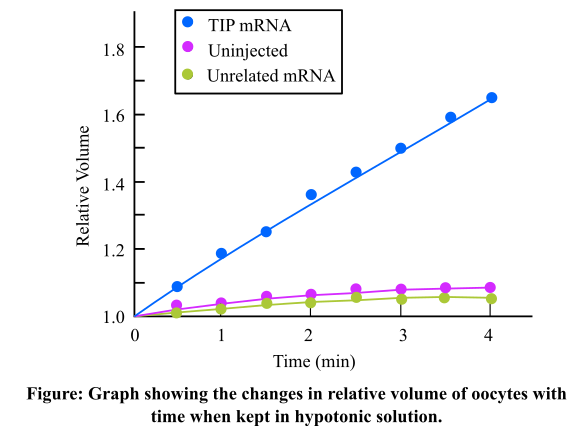
To review:
The role of tonoplast intrinsic protein (TIP) and the importance of the two mentioned conditions by the researchers in the experiment.
Given:
In the first case, researchers injected the oocytes of the frog Xenopus laevis which are large in size with a low osmotic cell permeability with the messenger ribonucleic acid (mRNA) of plant TIP. In the second case, the oocytes were injected with mRNA of a protein which does not help in transport whereas, in the third case, researchers kept the oocytes uninjected. They were observed after incubation of 2 days in isotonic medium and treatment with hypotonic solution.
The following graph was plotted showing the changes in relative volume of the different oocytes of the three cases over time:

It was also observed that the oocytes which were injected by TIP mRNA bursts after sometime while others do not. The following table depicts the osmotic water permeability of the three conditions as calculated by the researchers:

Introduction:
TIP is a transport protein present in the tonoplast of the plant cell. It helps in transport of molecules just like the other aquaporins. Also, hypotonic solution is that solution which has higher water potential than the cell so that due to the difference in water potential, the water moves inside the cell and swells up.
Explanation of Solution
From the graph, it can be concluded that with time, there is a significant increase in the volume of the oocytes that were injected with the mRNA of TIP. On the other hand, there is a very little increase in the relative volumes of the oocytes which were injected with mRNA of nontransport protein and the oocytes that were not injected at all. This happened due to the fact that when the oocytes were kept in the hypotonic solution, entry of water inside the cell took place because of the difference in water potential. The movement was rapid and in large quantity in the first case as compared to the second and the third case. The entry in the first case was rapid as TIP which is a transport protein increased the osmotic permeability of the oocytes, allowed the entry of more water and lead to the increase in volume of the oocytes.
Also, for the interpretation of the experiment the other two conditions were important as they proved that in absence of TIP the transportation occurs in a normal way and there is a little change in the volume of the oocytes.
Hence, it can be concluded that the TIP which is a transport protein is responsible for the increment in the relative volume of the oocyte cells as it increases their permeability and hence leads to their bursting.
Want to see more full solutions like this?
Chapter 34 Solutions
Life: The Science of Biology
- Pleas draw the Fischer projection and Haworth's projectionarrow_forwardPlease help me out of the following illustration thanksarrow_forward33.) 3.) Come up with 2 illustration of objects that exhibit patterns in nature and write a briefexplanation 3 to 5 sentences for each object illustrated.arrow_forward
- From your results, which component had the highest Rf value and which had the lowest? Based on your answer from the previous question, what could be the reason behind some components having an Rf value higher than the others? Compare the qualities of the two components that rendered the highest and lowest Rf After performing the simulation, what do you think are the possible practical applications of chromatographic techniques that are relevant to your program?arrow_forwardCan you explain how to find the answer and the calculation?arrow_forwardcould you put this in dimensional analysisarrow_forward
- Write Cif only statement A is correct, Hif only statement B is correct, Eif both statements are correct, Mif both statements are incorrect. A. For the Lineweaver-Burk plot, the slope of the line reflects the ratio between the maximum velocity and the Michaelis constant. B. Meanwhile, the y-intercept is the maximum velocity.arrow_forwardGive any two reasons why the patent on Basmati should not have gone at an american company.arrow_forwardCan you explain it? How can you determine the answer just by the data provided? Not by plotting any graph. If possible, can you provide the graph?arrow_forward
- Solve it Label Figures(a) and (b).arrow_forwardPlease note: Question 1 and 2 on the first image have been answered. It is there for reference in order to answer the main question which is Question 3. Thank you.arrow_forward(Please do not give solution in image format thanku) The COVID death toll in the US has reached an incomprehensible number of more then 1 million deaths. With benefit of hindsight assume you decided to form a health care consulting company with the mission of saving as many lives as possible. 1. Identify 4 main symptoms and map them to 3 main problems that are causing those symptoms. What decision criteria will you use to evaluate whether you have solved each problem?arrow_forward
 Human Anatomy & Physiology (11th Edition)BiologyISBN:9780134580999Author:Elaine N. Marieb, Katja N. HoehnPublisher:PEARSON
Human Anatomy & Physiology (11th Edition)BiologyISBN:9780134580999Author:Elaine N. Marieb, Katja N. HoehnPublisher:PEARSON Biology 2eBiologyISBN:9781947172517Author:Matthew Douglas, Jung Choi, Mary Ann ClarkPublisher:OpenStax
Biology 2eBiologyISBN:9781947172517Author:Matthew Douglas, Jung Choi, Mary Ann ClarkPublisher:OpenStax Anatomy & PhysiologyBiologyISBN:9781259398629Author:McKinley, Michael P., O'loughlin, Valerie Dean, Bidle, Theresa StouterPublisher:Mcgraw Hill Education,
Anatomy & PhysiologyBiologyISBN:9781259398629Author:McKinley, Michael P., O'loughlin, Valerie Dean, Bidle, Theresa StouterPublisher:Mcgraw Hill Education, Molecular Biology of the Cell (Sixth Edition)BiologyISBN:9780815344322Author:Bruce Alberts, Alexander D. Johnson, Julian Lewis, David Morgan, Martin Raff, Keith Roberts, Peter WalterPublisher:W. W. Norton & Company
Molecular Biology of the Cell (Sixth Edition)BiologyISBN:9780815344322Author:Bruce Alberts, Alexander D. Johnson, Julian Lewis, David Morgan, Martin Raff, Keith Roberts, Peter WalterPublisher:W. W. Norton & Company Laboratory Manual For Human Anatomy & PhysiologyBiologyISBN:9781260159363Author:Martin, Terry R., Prentice-craver, CynthiaPublisher:McGraw-Hill Publishing Co.
Laboratory Manual For Human Anatomy & PhysiologyBiologyISBN:9781260159363Author:Martin, Terry R., Prentice-craver, CynthiaPublisher:McGraw-Hill Publishing Co. Inquiry Into Life (16th Edition)BiologyISBN:9781260231700Author:Sylvia S. Mader, Michael WindelspechtPublisher:McGraw Hill Education
Inquiry Into Life (16th Edition)BiologyISBN:9781260231700Author:Sylvia S. Mader, Michael WindelspechtPublisher:McGraw Hill Education





